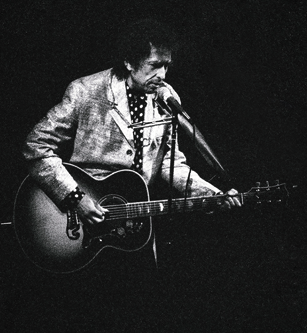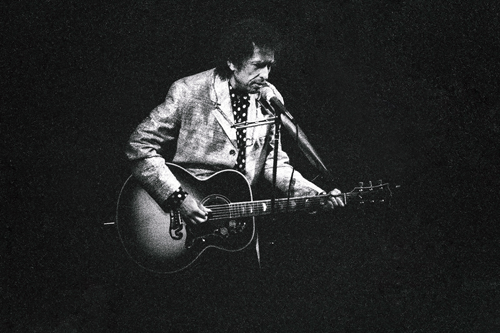When Bob Dylan turns another year older on May 24, the usual gaggle of journalists and Dylanophiles will report the news with the same sense of head-scratching, how-can-it-be wonderment they’ve expressed on Dylan’s birthday ever since America’s rock ’n’ roll poet laureate hit middle age. It’s as if, as a nation of nostalgia hounds, we simply can’t get our minds around the idea that Dylan could ever be an old man.
Or maybe it’s because even though Dylan has never gone willingly into whatever pigeonhole we’ve tried to cram him, we just can’t seem to keep ourselves from trying to label him or figure him out in some way.
We love him not a little because he seems so open to change, to following his heart and going in full steam ahead, damn the consequences.

(Photo © Bill Sperry)
As if we need reminding, first there was Robert Allen Zimmerman, the middle-class, Midwestern Jewish kid who changed his surname to Dylan and, with it, became the vagabond Pete Seeger clone who purported to live like a hobo en route to being discovered in the smoky coffeehouses of Greenwich Village. Then, a few years later, it was Dylan the folk troubadour and darling of the left-wingers, the revolutionary voice blowing in the wind against prejudice and bigotry. Next came “Traitor Bob,” the so-called scourge who committed the equivalent of folk music hara-kiri on stage at the Newport Folk Festival in 1965, when he picked up an electric guitar and played a blazing, blaring rendition of “Maggie’s Farm.” Tucked in there somewhere was “Dylan the Country Strummer,” the C&W crooner standing shoulder to shoulder with his close friend Johnny Cash and releasing the mainstream country album “Nashville Skyline.”
Label him what you will: indifferent, pugnacious, iconoclastic, unorthodox—whatever it might be that Dylan radiates. I know I speak for a lot of us to say we all wish we had a little more of it in ourselves.
And the list goes on. Most recently, it’s Bob the elder statesman, the icon, America’s most quixotic and charismatic senior citizen, on the road with his “Neverending Tour” and gigging around the globe for more than 85 shows a year.
By any measure, we’ve finally come around to admiring Bob Dylan for the label that sticks best on him—the one that reads “thoroughly confounding and completely unpredictable.” We love him not a little because he seems so open to change, to following his heart and going in full steam ahead, damn the consequences.
Label him what you will: indifferent, pugnacious, iconoclastic, unorthodox—whatever it might be that Dylan radiates. I know I speak for a lot of us to say we all wish we had a little more of it in ourselves.
Happy Birthday, Bob.
6 Favorite Songs by the Ever-Evolving Dylan
- “Masters of War.” Early Bob at his most socially conscious, this song tapped into a nation’s fear of nuclear war and the men who would wage it.
- “Maggie’s Farm.” Folk purists booed when Bob inaugurated his electric self with this song at the Newport Folk Festival in the summer of ’65. Today, it remains an anthem for anyone struggling against the status quo.
- “Lay Lady Lay.” One of Dylan’s biggest late-’60s hits, this and songs like“Peggy Day” characterize his country period. He actually wrote it to be included on the movie soundtrack for “Midnight Cowboy” but didn’t finish it in time.
- “Gotta Serve Somebody.” Recorded and produced in Muscle Shoals, Alabama, this song reflects Dylan’s religious period, when legions of his former fans turned on him. Despite the stigma, it won the Grammy for Best Rock Vocal by a Male in 1980.
- “Man in the Long Black Coat.” This is Old Testament Dylan, off his dark, swampy “Oh Mercy” LP (1980). The song and the album have a pre-apocalyptic pacing and feel that helped restore Dylan’s flagging popularity. Dylan himself referred to the song as “mysterious and revolutionary.”
- “Long and Wasted Years.” A later-period, American roots-based composition on Dylan’s 35th studio album, “Tempest,” this gem of a love-gone-wrong song perfectly captures the quixotic lyrical play that Dylan has long been famous for.




1 Comment
Ralph Pace
Good article, Bruce; it’s nice to read something that doesn’t try to justify him or analyze him bur simply accept him with warts and halos.